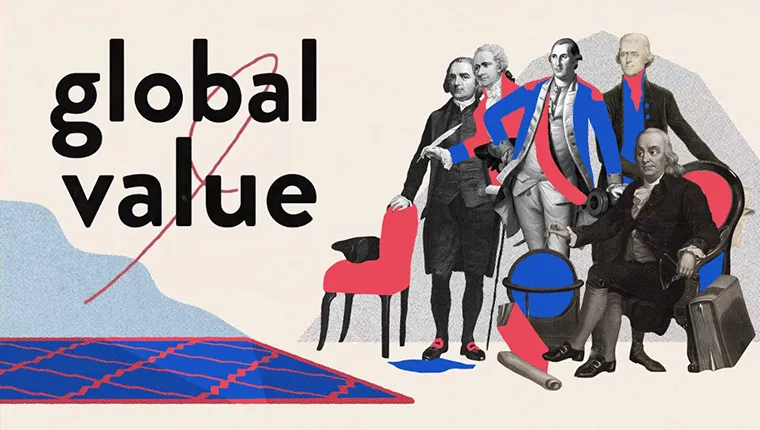The Global Role of the U.S. Dollar
Why is the U.S. dollar the world's most popular currency and how does it help the U.S. economy? Watch this video on the history of U.S. currency.
The global role of the dollar began in 1944 at the Bretton Woods conference. Today, it influences the world in several important ways.
Video Transcript: Why Is the U.S. Dollar So Popular Around the World?
Anywhere you go in the world, you’ll be able to find someone who wants U.S. dollars. People in other countries save in it, businesses make international deals in it, and banks and governments hold it in their reserves. So why is the dollar so popular around the world, and just how does global use of the dollar help the United States? Well, let’s start by examining the global value of U.S. currency.
History of the U.S. dollar
The dollar’s global status was cemented in 1944 when government representatives from around the world met in Breton Woods, New Hampshire. Their goal? Set up a new monetary system that would encourage international trade after World War II. Back then, credibility and desirability of a currency depended on how much gold the currency’s issuing country had. And at that time, the United States controlled two-thirds of the world’s supply of gold reserves, meaning that the U.S. dollar was the most credible currency in the world.
The representatives at Breton Woods decided to set their countries’ currencies at a fixed exchange rate with the U.S. dollar. This meant that one country’s currency could be exchanged with that country’s government for a set rate of U.S. dollars. Because all major currencies were fixed, or pegged, to the dollar, the dollar became the normal way of settling international payments, even when they didn’t involve the United States. For example, the Bank of Japan would use U.S. dollars to pay debts it owed the Bank of France. Japanese or European businesses with exports and imports would do the same, making the dollar the international medium of exchange.
What was known as the Bretton Woods system fell apart in the 1970s, when the United States announced that dollars could no longer be exchanged for gold. Thus, other countries started viewing the dollar with uncertainty, as it experienced relatively high inflation, losing value faster than it should. But starting in the 1980s, as the United States’ central bank, the Federal Reserve, got inflation under control, people from other countries once again felt confident that U.S. dollars would keep their value compared to other currencies.
The dollar has other advantages that make it popular, like network effects. Since there’s a large network of people who want the dollar, each individual is more likely to use it to trade with everyone else in the network, strengthening the dollar’s demand. Also, U.S. financial markets are the largest and most open in the world. This means that organizations with a lot of dollars are able to buy and sell a lot of financial assets, making huge transactions that could cause problems in smaller markets, but which U.S. financial markets can easily handle.
How does the global role of the dollar benefit the United States?
The global role of the dollar benefits the U.S. in three important ways.
Makes it cheaper for United States to borrow money
First, it makes it cheaper for the United States to borrow money. In 2018, the U.S. federal government spent 4.1 trillion dollars, but only collected 3.3 trillion dollars in taxes. The difference between the two numbers is called the budget deficit, and it’s not uncommon for the U.S. to have one. Whenever there’s a deficit, the government borrows dollars so that it has enough cash to cover all of its spending for the year. If it were to borrow in another currency, and the value of that currency rose in the future, more U.S. dollars would be needed to pay back its loans. Even so, borrowing that money isn’t free; the U.S. government pays interest on the dollars it borrows.
But because global demand for the U.S. dollar is high, other governments lend money more cheaply to the U.S. government than they otherwise would. This means less money is spent on interest payments, which are the cost of a loan, so more money is available to spend on other priorities like defense or infrastructure projects. This effect becomes larger when there’s military tension or financial uncertainty, as investors crave the safety of the dollar and shift more of their money into the U.S. This further reduces borrowing costs in times of crisis, right when the U.S. needs it most.
Makes life cheaper for average Americans
Second, the global role of the dollar makes life cheaper for average Americans. Demand for the U.S. dollar drives up its value, therefore increasing its purchasing power and allowing Americans to buy more goods and services from other countries. But there’s a flip side to this benefit. The stronger dollar makes it more expensive for foreigners to import American goods, so they buy less of them. Ultimately, this leads to fewer Americans working in export-related industries.
Get diplomatic advantage
Third, with the world saving and paying in dollars, the United States gets a diplomatic advantage. It can pressure adversaries like Iran with financial sanctions, which limits their ability to conduct international trade.
Of course, the U.S. dollar’s global role won’t necessarily last forever, say, if inflation rates get out of control and people lose confidence in the dollar, or if the U.S. share of the world’s economy and trade declines, and if the U.S. government allows its debt to grow too large. Or if it uses financial sanctions too often, the U.S. dollar could lose the characteristics that make it so desirable. And while it would take a long time, the currency of some other country, or countries, could replace it, and then those countries would receive cheaper loans and imports, and the United States would lose out.
To learn more about the U.S. dollar, explore CFR’s backgrounder, The Dollar: The World’s Currency.



